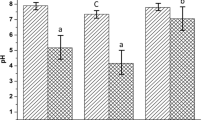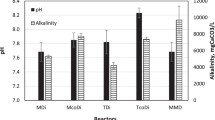Abstract
Batch experiments were performed to evaluate the biohydrogen and biomethane production by co-digestion of chicken manure and food waste in a two-stage mesophilic fermentation process. Results showed that no hydrogen was produced in the first stage of sole chicken manure fermentation, while methane yield was 247.3 mL·g−1-VS. By comparison, the co-digestion process with food waste proportions of 50–85% obtained hydrogen yields of 15.5–57.5 mL·g−1-VS, and the methane yields and maximum specific methane production rates were also improved by 7.0–16.7% and 80%, respectively. Moreover, the highest hydrogen and methane yields were achieved during sole food waste fermentation process. The acetate was the main volatile fatty acid (VFA) produced during sole chicken manure fermentation process in the first stage. Statistical analysis revealed that hydrogen production from co-digestion process and sole food waste fermentation process followed the n-butyrate-type pathway. Meanwhile, it should be noticed that the co-fermentation of chicken manure and food waste had antagonistic effects on the hydrogen fermentation, implying that there might be some inhibition factors existing in chicken manure or produced during the co-fermentation process. At the beginning of methane fermentation, the VFA profiles were similar to those at the end of hydrogen fermentation, and the main VFA compositions changed to acetate and propionate in the latter period of methane production. The volatile solid removal efficiencies were also promoted in co-digestion process compared with sole chicken manure digestion, which were increased by 9.7–14.4% with food waste proportions of 50–80%.
Graphical abstract







Similar content being viewed by others
Data Availability
The datasets generated during and/or analyzed during the current study are available from the corresponding author on reasonable request.
Code Availability
Not applicable.
References
NBSC (National Bureau of Statistics of China) (2020) China Statistical Yearbook [M], China Staistics Press, Beijing. Section 12.14. https://data.stats.gov.cn/easyquery.htm?cn=C01. Accessed 31 September 2021.
Fuchs, W., Wang, X., Gabauer, W., et al. (2018). Tackling ammonia inhibition for efficient biogas production from chicken manure: Status and technical trends in Europe and China[J]. Renewable and Sustainable Energy Reviews, 97, 186–199. https://doi.org/10.1016/j.rser.2018.08.038
Franqueto, R., Silva, J. D. D., Starick, E. K., et al. (2020). Anaerobic codigestion of bovine manure and banana tree leaf: The effect of temperature variability on biogas yield in different proportions of waste[J]. Journal of Material Cycles and Waste, 22(Part 2, 1), 1444–1458. https://doi.org/10.1007/s10163-020-01033-2
Massé, D. I., Croteau, F., & Masse, L. (2007). The fate of crop nutrients during digestion of swine manure in psychrophilic anaerobic sequencing batch reactors[J]. Bioresource Technology, 98(15), 2819–2823. https://doi.org/10.1016/j.biortech.2006.07.040
Pan, J., Ma, J., Zhai, L., et al. (2019). Enhanced methane production and syntrophic connection between microorganisms during semi-continuous anaerobic digestion of chicken manure by adding biochar[J]. Journal of Cleaner Production, 240, 118178. https://doi.org/10.1016/j.jclepro.2019.118178
Wang, M., Sun, X., Li, P., et al. (2014). A novel alternate feeding mode for semi-continuous anaerobic co-digestion of food waste with chicken manure[J]. Bioresource Technology, 164, 309–314. https://doi.org/10.1016/j.biortech.2014.04.077
Sun, C., Cao, W., Banks, C. J., et al. (2016). Biogas production from undiluted chicken manure and maize silage: A study of ammonia inhibition in high solids anaerobic digestion[J]. Bioresource Technology, 218, 1215–1223. https://doi.org/10.1016/j.biortech.2016.07.082
Liu, X. Y., Li, R. Y., Ji, M., et al. (2013). Hydrogen and methane production by co-digestion of waste activated sludge and food waste in the two-stage fermentation process: Substrate conversion and energy yield[J]. Bioresource Technology, 146, 317–323. https://doi.org/10.1016/j.biortech.2013.07.096
Oladejo, O. S., Dahunsi, S. O., Adesulu-Dahunsi, A. T., et al. (2020). Energy generation from anaerobic co-digestion of food waste, cow dung and piggery dung[J]. Bioresource Technology, 313, 123694. https://doi.org/10.1016/j.biortech.2020.123694
Tuan Yusof, T. R., Abdul Rahman, N. A., Ariff, A., et al. (2019). Evaluation of hydrogen and methane production from co-digestion of chicken manure and food waste[J]. Polish Journal of Environmental Studies, 28(4), 3003–3014. https://doi.org/10.15244/pjoes/86222
Liu, X., Li, R., & Ji, M. (2019). Effects of two-stage operation on stability and efficiency in co-digestion of food waste and waste activated sludge[J]. Energies, 12(14), 2748. https://doi.org/10.3390/en12142748
Guo, X. M., Trably, E., Latrille, E., et al. (2010). Hydrogen production from agricultural waste by dark fermentation: A review[J]. International Journal of Hydrogen Energy, 35(19), 10660–10673. https://doi.org/10.1016/j.ijhydene.2010.03.008
IRENA (The International Renewable Energy Agency) (2019) Hydrogen-A renewable energy perspective. The 2nd Hydrogen Energy Ministerial Meeting. https://www.irena.org/publications/2019/Sep/Hydrogen-Arenewable-energy-perspective. Accessed 31 September 2021.
Jarunglumlert, T., Prommuak, C., Putmai, N., et al. (2018). Scaling-up bio-hydrogen production from food waste: Feasibilities and challenges[J]. International Journal of Hydrogen Energy, 43(2), 634–648. https://doi.org/10.1016/j.ijhydene.2017.10.013
Kobayashi, T., Xu, K.-Q., Li, Y.-Y., et al. (2012). Evaluation of hydrogen and methane production from municipal solid wastes with different compositions of fat, protein, cellulosic materials and the other carbohydrates[J]. International Journal of Hydrogen Energy, 37(20), 15711–15718. https://doi.org/10.1016/j.ijhydene.2012.05.044
Aslan, M., Gümüş, M., & Türkmenler, H. (2020). The effect of organic loading, protein and carbohydrate on biohydrogen production from soft shell of red pistachio, sugar beet pulp, and olive pulp cake[J]. Energy Sources, Part A: Recovery, Utilization, and Environmental Effects, 1-13. https://doi.org/10.1080/15567036.2020.1829197
APHA (Ed.). (2005). Standard methods for the examination of water and wastewater (21st ed.). APHA.
Yu, Q., Cui, S., Sun, C., et al. (2021). Synergistic effects of anaerobic co-digestion of pretreated corn stover with chicken manure and its kinetics[J]. Applied Biochemistry and Biotechnology, 193(2), 515–532. https://doi.org/10.1007/s12010-020-03445-0
Rafieenia, R., Pivato, A., Campanaro, S., et al. (2019). Study of microbial dynamics during optimization of hydrogen production from food waste by using LCFA-rich agent[J]. Bioresource Technology Reports, 5, 157–163. https://doi.org/10.1016/j.biteb.2019.01.011
Kim, S. H., Han, S. K., & Shin, H. S. (2004). Feasibility of biohydrogen production by anaerobic co-digestion of food waste and sewage sludge[J]. International Journal of Hydrogen Energy, 29(15), 1607–1616. https://doi.org/10.1016/j.ijhydene.2004.02.018
Niu, Q., Qiao, W., Qiang, H., et al. (2013). Mesophilic methane fermentation of chicken manure at a wide range of ammonia concentration: Stability, inhibition and recovery[J]. Bioresource Technology, 137(Complete), 358–367. https://doi.org/10.1016/j.biortech.2013.03.080
Dalkilic, K., & Ugurlu, A. (2017). Influence of hydraulic retention time and reactor configuration during fermentation of diluted chicken manure[J]. Applied Biochemistry and Biotechnology, 181(1), 157–176. https://doi.org/10.1007/s12010-016-2205-6
Jurgutis, L., Slepetiene, A., Volungevicius, J., et al. (2020). Biogas production from chicken manure at different organic loading rates in a mesophilic full scale anaerobic digestion plant[J]. Biomass and Bioenergy, 141, 105693. https://doi.org/10.1016/j.biombioe.2020.105693
Dalkilic, K., & Ugurlu, A. (2015). Biogas production from chicken manure at different organic loading rates in a mesophilic-thermopilic two stage anaerobic system[J]. Journal of Bioscience and Bioengineering, 120(3), 315–322. https://doi.org/10.1016/j.jbiosc.2015.01.021
Algapani, D. E., Qiao, W., Ricci, M., et al. (2019). Bio-hydrogen and bio-methane production from food waste in a two-stage anaerobic digestion process with digestate recirculation[J]. Renewable Energy, 130, 1108–1115. https://doi.org/10.1016/j.renene.2018.08.079
Cheng, J., Ding, L., Lin, R., et al. (2016). Fermentative biohydrogen and biomethane co-production from mixture of food waste and sewage sludge: Effects of physiochemical properties and mix ratios on fermentation performance[J]. Applied Energy, 184, 1–8. https://doi.org/10.1016/j.apenergy.2016.10.003
Ghimire, A., Sposito, F., Frunzo, L., et al. (2016). Effects of operational parameters on dark fermentative hydrogen production from biodegradable complex waste biomass[J]. Waste Management, 50(Apr.), 55–64. https://doi.org/10.1016/j.wasman.2016.01.044
Gao, C., Zhao, M., Huang, Z., et al. (2018). Hydrogen consumption capacity assessment and its inhibition in the dry anaerobic digestion process from food waste[J]. Journal of Renewable and Sustainable Energy, 10(5), 053104. https://doi.org/10.1063/1.5045117
Ziara, R. M. M., Miller, D. N., Subbiah, J., et al. (2019). Lactate wastewater dark fermentation: The effect of temperature and initial pH on biohydrogen production and microbial community[J]. International Journal of Hydrogen Energy, 44(2), 661–673. https://doi.org/10.1016/j.ijhydene.2018.11.045
Guo, R., Liu, X., Hu, Y., et al. (2020). Stronger stimulation of waste activated sludge anaerobic fermentation by a particular amount of micron-sized zero valent iron[J]. Applied Biochemistry and Biotechnology, 192(1), 313–324. https://doi.org/10.1007/s12010-020-03339-1
Wang, Y., & Wang, S. (2021). Soft sensor for VFA concentration in anaerobic digestion process for treating kitchen waste based on SSAE-KELM[J]. IEEE Access, 9, 36466–36474. https://doi.org/10.1109/ACCESS.2021.3063231
Kaur, G., Johnravindar, D., & Wong, J. W. C. (2020). Enhanced volatile fatty acid degradation and methane production efficiency by biochar addition in food waste-sludge co-digestion: A step towards increased organic loading efficiency in co-digestion[J]. Bioresource Technology, 308, 123250. https://doi.org/10.1016/j.biortech.2020.123250
Liu, X., Li, R., Ji, M., et al. (2020). Effects of initial pH on two-stage biogas production and hydrolysis in a co-digestion process of food waste and waste activated sludge[J]. Environmental Engineering Science, 38(4), 266–276. https://doi.org/10.1089/ees.2020.0221
Wang, Y., Zhang, Y., Wang, J., et al. (2009). Effects of volatile fatty acid concentrations on methane yield and methanogenic bacteria[J]. Biomass and Bioenergy, 33(5), 848–853. https://doi.org/10.1016/j.biombioe.2009.01.007
Bojti, T., Kovacs, K. L., Kakuk, B., et al. (2017). Pretreatment of poultry manure for efficient biogas production as monosubstrate or co-fermentation with maize silage and corn stover[J]. Anaerobe, 46, 138–145. https://doi.org/10.1016/j.anaerobe.2017.03.017
Chen, Y., Xiao, N., Zhao, Y., et al. (2012). Enhancement of hydrogen production during waste activated sludge anaerobic fermentation by carbohydrate substrate addition and pH control[J]. Bioresource Technology, 114(none), 349–356. https://doi.org/10.1016/j.biortech.2012.03.052
Saad, M. F. M., Rahman, N. A. A., & Yusoff, M. Z. M. (2019). Hydrogen and methane production from co-digestion of food waste and chicken manure[J]. Polish Journal of Environmental Studies, 28(4), 2805–2814. https://doi.org/10.15244/pjoes/83670
Acknowledgements
The authors are grateful to the financial support from the National Key R&D Program of China (2018YFD1100503).
Funding
This work was supported by the National Key R&D Program of China (2018YFD1100503).
Author information
Authors and Affiliations
Contributions
All authors contributed to the study conception and design. Formal analysis and investigation: Xinyuan Liu and Yuyu Yang. Writing—original draft preparation: Xinyuan Liu. Writing—review and editing: Nan Wu. Funding acquisition: Hui Zhao. Supervision: Yong Wei and Huiyong Shan. All authors read and approved the final manuscript.
Corresponding author
Ethics declarations
Ethics Approval
Not applicable.
Consent to Participate
Not applicable.
Consent for Publication
Not applicable.
Conflict of Interest
The authors declare no competing interests.
Additional information
Publisher’s Note
Springer Nature remains neutral with regard to jurisdictional claims in published maps and institutional affiliations.
Highlights
• Co-digestion of food waste (FW) and chicken manure (CM) produced H2 and CH4.
• The lowest H2 and CH4 yields were obtained at CM proportions of 0–30%.
• Antagonistic effects on H2 fermentation occurred in co-fermentation of FW and CM.
• H2 production from FW and co-substrates followed n-butyrate pathway.
• Digestion efficiencies were enhanced by co-digestion compared to sole CM digestion.
Supplementary Information
ESM 1
(DOC 72 kb)
Rights and permissions
About this article
Cite this article
Liu, X., Yang, Y., Wu, N. et al. Co-production of Biohydrogen and Biomethane from Chicken Manure and Food Waste in a Two-Stage Anaerobic Fermentation Process. Appl Biochem Biotechnol 194, 3706–3720 (2022). https://doi.org/10.1007/s12010-022-03945-1
Published:
Issue Date:
DOI: https://doi.org/10.1007/s12010-022-03945-1




